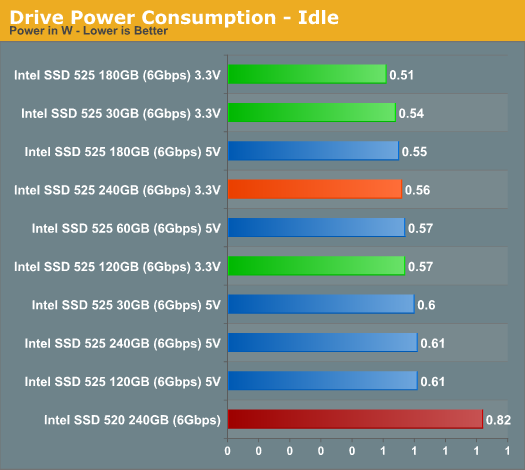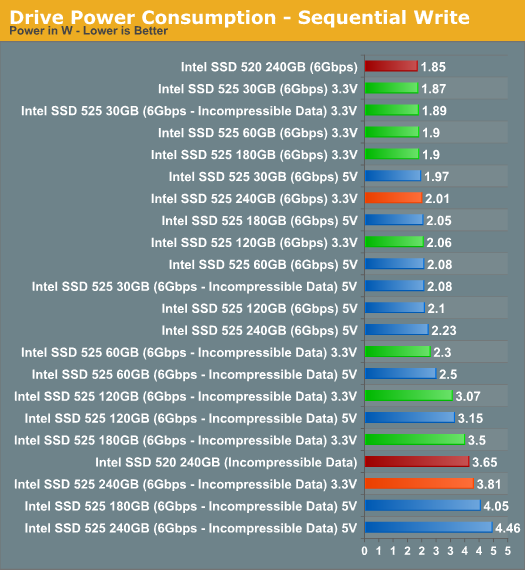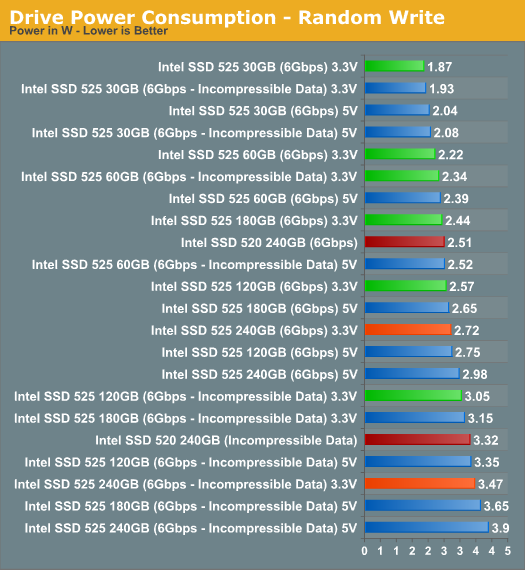An Update on Intel's SSD 525 Power Consumption
by Anand Lal Shimpi on February 20, 2013 3:55 PM EST- Posted in
- Storage
- SSDs
- Intel
- Intel SSD 525
Intel's SSD 525 is the mSATA version of last year's SF-2281 based Intel SSD 520. The drive isn't just physically smaller, but it also features a new version of the Intel/SandForce firmware with a bunch of bug fixes as well as some performance and power improvements. Among the improvements is a tangible reduction in idle power consumption. However in our testing we noticed higher power consumption than the 520 under load. Intel hadn't seen this internally, so we went to work investigating why there was a discrepancy.
The SATA power connector can supply power to a drive on a combination of one or more power rails: 3.3V, 5V or 12V. Almost all 2.5" desktop SSDs draw power on the 5V rail exclusively, so our power testing involves using a current meter inline with the 5V rail. The mSATA to SATA adapter we use converts 5V to 3.3V for use by the mSATA drive, however some power is lost in the process. In order to truly characterize the 525's power we had to supply 3.3V directly to the drive and measure at our power source. The modified mSATA adapter above allowed us to do just that.
Idle power consumption didn't change much:

Note that the 525 still holds a tremendous advantage over the 2.5" 520 in idle power consumption. Given the Ultrabook/SFF PC/NUC target for the 525, driving idle power even lower makes sense.
Under load there's a somewhat more appreciable difference in power when we measure directly off of a 3.3V supply to the 525:

Our 520 still manages to be lower power than the 525, however it's entirely possible that we simply had a better yielding NAND + controller combination back then. There's about a 10 - 15% reduction in power compared to measuring the 525 at the mSATA adapter's 5V rail with the 240GB model.

There story isn't any different in our random write test. Measuring power sent direct to the 525 narrows the gap between it and our old 520 sample. Our original 520 still seems to hold a small active power advantage over our 525 samples, but with only an early sample to compare to it's impossible to say if the same would be true for a newer/different drive.
I've updated Bench to include the latest power results.










8 Comments
View All Comments
RU482 - Wednesday, February 20, 2013 - link
bravo on your follow through on this one!ssj3gohan - Thursday, February 21, 2013 - link
Awesome that you fixed this measurement error (ahem.. sorry to be boasting but... I told you so :P), but you're still not quite there. Look at the datasheet. Now look at bench. See the giant difference?That's DIPM. Enable it and you'll have entirely correct measurements.
ssj3gohan - Thursday, February 21, 2013 - link
(failing an edit function, I'm replying to my own post)Edit: I see that Anand said there will be DIPM-only testing in 2013. Great. Just keep in mind that all power consumption measurements you have now don't really mean anything to desktop and laptop use cases. They only apply to server workloads where DIPM doesn't exist, or workloads where the SSD is constantly hammered at maximum speed.
asphyxxiate - Thursday, February 21, 2013 - link
Ahem. This is a weird place to do this, but I'm a huge fan of your work. It's truly awe-inspiring. Can't wait for the MADPSU! (And more updates in English, please. Sometimes Google Translate just doesn't cut it ;) )ssj3gohan - Friday, February 22, 2013 - link
Uh... thanks :) but yeah, this really isn't the place. I'll update my blog very soon about MADPSU.[/completely offtopic interlude]
ABR - Friday, February 22, 2013 - link
While performance per watt is surely there, these all fall short in absolute terms of the best 5400 RPM regular hard drives, which come in around 1.5W under load. (And regular hard drives don't care if you're writing incompressible or not.) I'd like to think the technology will get there eventually, but as with cars over the last couple of decades there seems to be a never-ending focus on (horse)power.phillyry - Sunday, February 24, 2013 - link
But these race to sleep sooner and therefore use less power for the same work (see the iPhone 5 review for an overview of this concept).So, not only will the SSD use less power but so will the system.
will2 - Sunday, April 7, 2013 - link
Any thoughts if the 240GB 525 + mSATA>2.5" adapter a better choice over a 520 or Sammy 840 for an efficient ultrabook ?With that in mind, does anyone know if: a) the adapter degrades speed (are data+control lines direct connection ?), b) which make of adapter Anand used, c) if choice of adapter affects compatibility ?
The Intel datasheet states typ Idle 250mW, Active 300mW; any explanation why measured Idle is double the Intel spec ? Do the measured active consumptions, eg. 3.47W during Random Wr, accord with (am guessing the 10:1 disparity due to Intel using avg power over time) the Intel active 300mW 'typ' spec ?